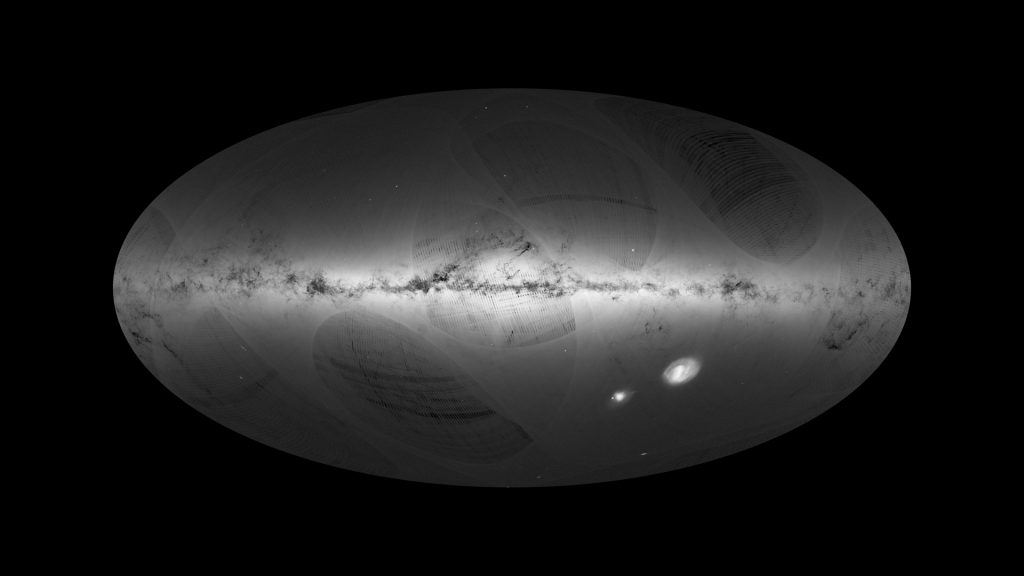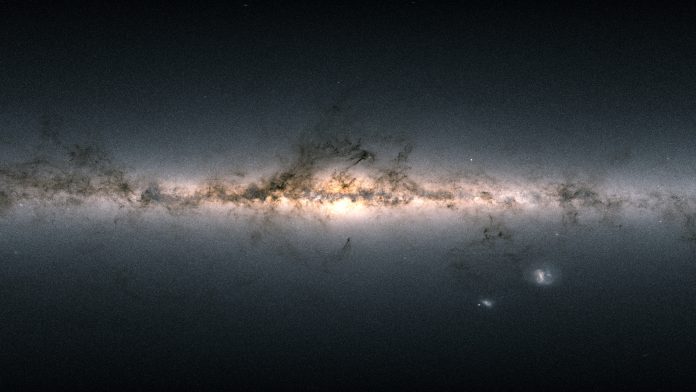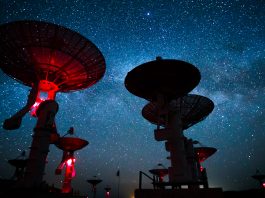As the Gaia mission continues, Tineke Roegiers of HE Space Operations for the European Space Agency talks to Innovation News Network about what the mission has taught us so far and what we still have to learn as the spacecraft nears seven years of operation.
The Gaia mission is creating a census of our Universe. Launched into space in 2013, it aims to survey over one thousand million stars across our Galaxy, carefully recording any changes alongside their movements and positions using spectrophotometric measurements. The data from this mission will provide a wide range of data that will allow us to further examine the origins, structure, and history of our galaxy. So far, the mission has yielded unprecedented results, with the discovery of the galaxy Antlia 2 and the Radcliffe wave, among others.
Gaia’s first releases brought the discovery of many new star streams, helped discover new clusters, and brought a deeper understanding of the historic events that shaped our Milky Way. But this is only the beginning! More data, more types of data, and more accurate data will follow, promising a true treasure chest for astronomers.
Clifford Holt, International Editor for Innovation News Network, spoke with Tineke Roegiers, HE Space Operations for the European Space Agency, about the Gaia mission and its ongoing impact.
Gaia’s main objective is to conduct an astronomical census of 1 billion stars. Why is this important?
Knowing where the stars are located and how they move is essential information. This information can disclose a lot about the galaxy now, its history, and its future. Hipparcos, the predecessor of the Gaia mission, created a map of 117,955 stars with a precision of 1 milli-arcsecond. Now, with Gaia’s latest release, a map has been created of more than 1.8 billion stars with an even higher precision.
Gaia’s catalogue contains the positions of the stars, but also a measure for their distance and how they move across the sky. You could consider Gaia to be a Milky Way cartographer. To know the position and motion of stars allows us to investigate the structures in our Milky Way, like, for example, star clusters and star streams – which stars move together in space and where are they heading or coming from. This information can also help disclose if stars, or streams and clusters, were disrupted along their way.
While Hipparcos was limited to a region around the Solar System, Gaia can see further, all the way to the disk of the Milky Way and (in the other direction) all the way into the halo.
Gaia will also potentially detect between 10,000 and 50,000 planets beyond our Solar System. How will it do this?
On average, Gaia will observe a star 70 times over its nominal five-year mission. Gaia uses two optical telescopes that work with three science instruments and precisely determines the location of stars and their brightness, before splitting their light into a spectrum to obtain further data. After sending the raw data down to Earth, the data is extensively processed by a consortium of scientists and engineers to generate the scientific data products from all observations, which are shared with the community through data releases.
The spacecraft is designed to spin slowly and moves around the Sun in one year, allowing its two telescopes to cover the entirety of the celestial sphere.
The mission has a firm approved mission extension until the end of 2022, and a first indicative mission extension until the end of 2025. This means Gaia could be operating for more than 10 years, and thus observing stars on average more than 140 times.
Gaia will detect exoplanets through precise astrometric measurements of stars by observing the tiny wobble in the position and motion of the star caused by the movement of the exoplanet around its host star. Gaia will also detect exoplanets by observing small dips in the brightness of the star caused by the exoplanet moving in front of the host star and temporarily blocking the light coming from it. Small dips in the brightness can have other causes. For example, the star can be variable, or could be undergoing an explosion, or even be a double star. One of the challenges in the processing is to figure out what is causing this dip in brightness and how to classify the star in this respect. These classifications are one of the products of the Gaia mission.
Similarly, what will the mission’s objectives concerning asteroids etc. help to achieve?
Gaia helps to improve our knowledge on the Solar System in many ways. By providing good stellar positions and motions, the predictions of stellar occultations (the movement of an asteroid in front of a star as seen from Earth) have improved a lot, with more narrow predicted shadow paths on Earth (so the location where you could possibly see the star being occulted by the asteroid). Because these predicted shadow paths on Earth have significantly decreased in size, the chance of actually capturing the stellar occultation has increased. Stellar occultation observations allow us to learn a lot about the asteroid moving in front of the star, about its shape, but also if the asteroid has rings, for example.
The improved knowledge on stellar positions and motions is also used to reprocess images taken from asteroids years ago. The relative position of the asteroid in that image with respect to the stars can be computed more precisely because the position and motion of the stars as seen on that same image are now known a lot better. This improved knowledge of the asteroid’s historic position (as obtained with our current improved knowledge of the stars) is then used to recompute the asteroid’s orbit. This has been done for a lot of the near-earth asteroids and helps us to identify which asteroids are more or less dangerous to us here on Earth.
The improved orbits of the asteroids (as recomputed following the improved star knowledge from Gaia) are also important to allow observing the asteroid in the future knowing its orbit better improves the chance of observing the asteroid again, and each successful observation of the asteroid then improves the knowledge of its orbit.
In addition to helping out with star data, Gaia, also observes asteroids directly. Gaia Data Release 2 already contains 14,099 asteroids1 and Gaia Data Release 3 is expected to contain about 150,000 asteroids.
Gaia is an all-sky survey mission, and hence can also observe asteroids in the regions which are not extensively observed by ground-based surveys, such as certain regions within the area between the Sun and the Earth.
In addition to observing known asteroids, Gaia has the potential of discovering new asteroids. A few already have been discovered including 2018 YK4, 2018 YL4 and 2018 YM4.

How will Gaia help to test Einstein’s theory of General Relativity?
Einstein’s theory of General Relativity posits that massive objects, such as galaxies, can bend the fabric of spacetime, acting like a lens and deflecting the light of distant objects. However, it took until 1979 to create the first double image of a lens quasar, and until 1985 for the first quadruple image, and these images support Einstein’s theory.
The specific celestial image of an Einstein cross is a quadruple image quasar and is extremely rare, with only around 50 discovered in the last 40 years. Gaia can change this because it can regularly survey the whole sky with unprecedented spatial resolution. Multiple image quasars help us to measure fundamental cosmic parameters such as the Universe’s rate of expansion and the Hubble-Lema ître constant, one of the pieces of evidence most frequently used to support the Big Bang theory about the origins of the Universe.
Following the recently published Early Data Release 3, are there any signs of what could be expected from the final release? And are there hopes that Gaia will continue beyond its already extended lifetime?
Gaia started its routine operations in July 2014 and in July 2019 moved into its first mission extension. Since January 2021, Gaia has been operating in its second mission extension which runs to the end of 2022. An indicative extension has been given for Gaia for the period from January 2023 to end of 2025.
The Gaia relies on its micro-propulsion system for keeping a stable scanning mode. Once the propellant is depleted, this scanning mode can no longer be maintained with the needed high stability. It is currently estimated that the propellant will be depleted in early 2025. Gaia Flight Operations team puts in a lot of effort to make sure manoeuvres are scheduled in the most efficient way to make sure the propellant will last as long as possible.
After the retirement of the Gaia space telescope, the Gaia mission will go into its post-operations phase and start preparing the final catalogue based on all data gathered during its nominal mission lifetime and its full extension period.
Meanwhile, the Gaia Consortium is working around the clock to produce the releases before the final one. Currently, Gaia Data Release 3 is being validated and documented. Gaia Data Release 4 data is being pushed into the very first pipelines of the Gaia data processing. Producing a Gaia Data Release is a big effort, involving more than 400 scientists and engineers with very specific skills and expertise. They work from many different institutes across Europe (and with some small contributions from outside Europe as well). The data contained in the releases does not yet contain the full nominal mission time (five years). Gaia Data Release 1 is based on the first 14 months of data gathered (released in September 2016). Gaia Data Release 2 is based on the first 22 months of data gathered (released in April 2018). Gaia Early Data Release 3 is based on the first 34 months of data gathered (released in December 2020) and is the first batch of the Gaia Data Release 3. The full Gaia Data Release 3 is expected to be released in the first half of 2022 and will also be based on this first 34 months of data. Gaia Data Release 4 will be based on the full nominal mission period plus an additional six months, so will be based on 66 months of data. Later, Gaia will also release the data gathered in the mission extension phases.
What is expected with Gaia Data Release 3, dependent on the validation of the data is:
- Object classification and astrophysical parameters, together with the BP/RP spectra and/or RVS spectra they are based on, for spectroscopically and spectrophotometrically well-behaved objects;
- Mean radial velocities for stars with available atmospheric parameter estimates;
- Variable-star classifications together with the epoch photometry used for the stars;
- Solar System results with preliminary orbital solutions and individual epoch observations;
- Non-single stars;
- Quasars and Extended Objects results; and
- An additional data set, called the Gaia Andromeda Photometric Survey (GAPS), consisting of the photometric time series for all sources located in a 5.5-degree radius field centred on the Andromeda galaxy.
Furthermore, what is expected with Gaia Data Release 4 is:
- Full astrometric, photometric, and radial-velocity catalogues;
- All available variable-star and non-single-star solutions;
- Source classifications (probabilities) plus multiple astrophysical parameters (derived from BP/RP, RVS, and astrometry) for stars, unresolved binaries, galaxies, and quasars. Some parameters may not be available for faint(er) stars;
- An exo-planet list; and
- All epoch and transit data for all sources2
Not to forget, after Gaia DR4 (which is based on five and a half years of data), another release will follow, containing the data of the mission extensions.
References
2. www.cosmos.esa.int/web/gaia/release
Tineke Roegiers
Gaia Project Information Co-ordinator
HE Space for the European Space Agency
https://sci.esa.int/web/gaia
Please note, this article will also appear in the seventh edition of our quarterly publication.









